How to make a mower for a walk-behind tractor with your own hands?
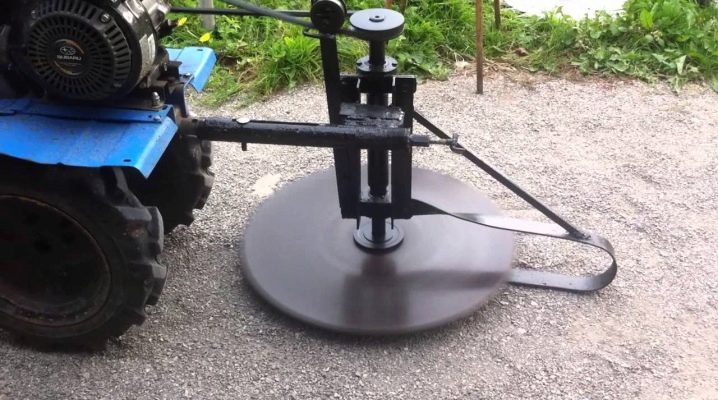
A walk-behind tractor is a good helper for any owner of a personal plot. You can expand the functionality of such home appliances with the help of various additional attachments, including a mower, but craftsmen prove that you do not need to spend money for this at all. If you have a desire and some simple materials at hand, you can make the equipment yourself.
Required tools and materials
Considering that the schemes for the manufacture of mowers, which will be given in our article below, were invented taking into account the use of scrap materials, any of these components can be replaced. If you are unable to get any of the specified materials, but have an idea how to replace it, you are free to make changes to our offer.
We offer only an indicative list of what may come in handy:
- welding;
- fasteners;
- metal corners;
- the bottom of an unnecessary iron barrel or any other piece of metal of a similar shape;
- several cutting plates;
- axle for wheels;
- wheels.




Instructions for creating
A lawn mower for a walk-behind tractor is not so complicated, but even it can be assembled using different methods. Most often, it is still not made from scratch - attachments, that is, the mower itself is made by the factory method at the factory, while the tasks of the folk craftsman are more likely to create an appropriate cart. The task does not seem difficult even in light of the fact that drawings of such structures are freely walking on the Internet, and if you wish, you can even find training videos on how to equip such a mechanism with your own hands.
The resulting device will belong to one of at least three types of mowers, each of which has its own design features, as well as its own advantages and disadvantages. Each of these mowers is worth a closer look - and that's what we'll do.
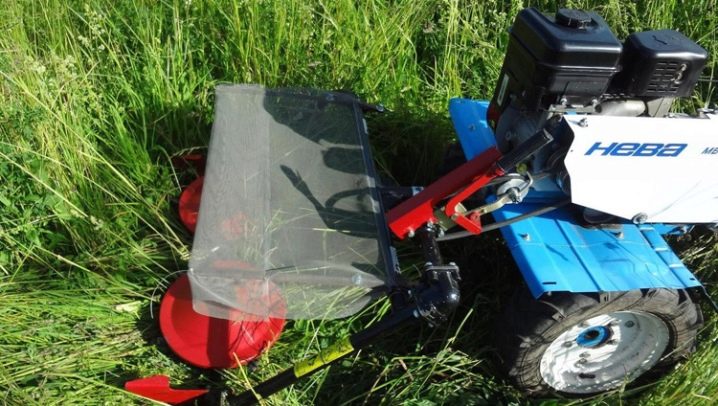
Rotary
Mowers of this type are mainly used for lawn maintenance and hay making. The unit is designed for use in areas with relatively low vegetation and a small number of small bushes. The performance of the structure is estimated very high, however, it is whimsical to the presence of slopes - 10-20 degrees is already the limit for it, and lateral roll is allowed and no more than 8 degrees. With the simplicity of the device and the minimum risk of breakage, the ability of the unit to fold grass in rows pleases, however, one should not forget that this particular type of mower is a traumatic one.
We suggest making knives from a regular chainsaw chain, cutting it into pieces of equal length.

Such improvised knives are usually attached 4 pieces to each of the rotating circles. - most often they are done by 2 using discs from a grain seeder. Fragments of the chain are attached to the discs at regular intervals, while they are not fixed perfectly tightly, but with a small gap of just a couple of millimeters. The latter is necessary so that the knives are maximally exposed to the centrifugal force, which will allow them to always be in a horizontal position. It is not worth fixing them more stably, and simply because when they join with something solid, they should be able to simply bounce back, otherwise the breakdown of the unit cannot be avoided.

All attachments for rotating parts must be made of high-strength steel with a high carbon content, the thickness of the pins should not be less than 8 or even 10 millimeters to avoid damage to the device and injury. After that, it remains only to assemble the frame. The frame is usually made from a pre-prepared axle and two wheels, onto which metal corners are welded. The rotor body can be made using the same bottom from a metal barrel, it is then that the axles for rotating the discs will be welded to it.
When installing the frame, it is necessary to provide for the possibility of connecting the disks with the PTO drive of the walk-behind tractor - for this purpose, gears from a gearbox from an old Soviet car like a VAZ can be used.

The transmission of torque must be organized in such a way that the discs rotate in the opposite direction in relation to each other. - it is this solution that allows the mowed grass to be folded in neat rows. The last step is to install some kind of protective cover over the frame to ensure that a piece of knife that comes off accidentally does not fly towards the operator.

Segmental
Such a self-made design is already noticeably more complicated in its structure, however, it also has its advantages. Unlike rotary models, here the knives do not move in a circle, but reciprocally, since they are fixed on a shaft. This unit provides extremely low pruning of plants, removing them at the root, and also such a device will not be able to chop already cut grass, as it could happen with a rotary mower. The mechanism is convenient even in conditions of work on uneven ground, and turning on and off is not connected in any way with the walk-behind tractor, which allows you to quickly respond to potential emergency situations. Finally, such a unit hardly vibrates, which is also useful for its safety.

As the main part, they take a rectangular pipe with parameters 120x5x1.5 cm or even just a piece of a scythe blade. In this workpiece, 12 holes are made at regular intervals, each with a diameter of a centimeter, into which M8 bolts will be screwed. The task of the latter is to hold the guide strip made of metal, whose length is 89 cm - it is on it that the teeth and knives are attached, which will ensure the mowing of the vegetation.
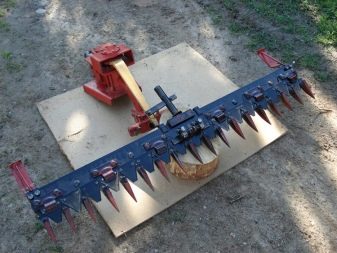

The torque is supplied to the main units of the segment mower from the power take-off shaft of the used power unit. With this in mind, a support chassis is cooked, on which the above-described mechanism with clamps is installed, preventing the non-directional movement of knives and teeth. The chassis design usually involves the installation of only 1 wheel for a segment mower, therefore the entire unit, including the walk-behind tractor, turns out to be three-wheeled.
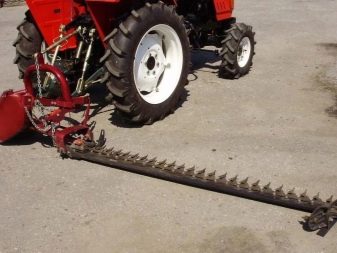

Mower-carriage
It is somewhat more difficult to make such a design than a rotary one, although in general they are very similar. This version of the lawn mower has been somewhat improved, it is often also called a drum mower, since the mechanism is based on rotating drums. The reinforced unit acquires the ability to withstand more durable obstacles, therefore it will cope not only with thick trunks of plants, but as a result of changing nozzles in the winter, it can be used as a small snowplow, even ice is not afraid of it.
The increased complexity of the assembly lies in the fact that if the above structures had a rather simple chassis scheme with two or even one wheel, then in this case it will be necessary to assemble a full-fledged four-wheeled cart, which is assembled from metal corners and pre-prepared axles and wheels.
The last details can be taken, for example, from an old baby carriage, the bottom of the structure is made of metal sheet, although in extreme cases, you can also use reliable plywood. The recommended dimensions for such a cart are usually 80x40 cm.


Cylinders, or drums, can be made in two different ways. In the simplest version, ordinary tin cans without a bottom and a lid are used for this purpose, put on wooden rounds, but if there are none at hand, their analogue is made of sheet metal. Metal discs are made in a diameter of 20 cm (outer) and 17 cm (inner), fastened together with a thick metal pin and are also attached to the carriage from the bottom side. Between these discs, the knives are attached according to the same rules as in the case of a rotary mower - a small gap is left so that the cutting element can rotate freely in any direction without threatening to escape from an accidental collision with an insurmountable obstacle.

After the cylinders are securely attached to the structure of the wagon, they are connected together with a rubber strap. It is also used to connect to the power take-off shaft of the walk-behind tractor, from where the torque is transmitted to the drums. The knives are designed for processing grass in the summer, however, other attachments are needed to remove snow - in the form of stars, sharp on all sides. If possible, it is necessary to try to make the design as simple as possible to disassemble so that the seasonal replacement of one nozzle for another does not turn into a full-scale assembly of a new unit from the wreckage of the old one.


Installation
One of the main pitfalls in making a do-it-yourself mower is not even that, as a result of hard work, the mechanism may never work, but in the potential danger of a unit made with obvious mistakes.
The injury hazard of such structures is often quite high due to improperly selected materials or unreliable welding works, therefore in many cases it is more advisable to purchase ready-made equipment or at least order welding to a professional in their field.


If you nevertheless got fired up with the idea of making your own lawn mower for a walk-behind tractor, pay attention to the fact that even a properly assembled device will not work if it is incorrectly connected to the walk-behind tractor. To avoid common mistakes, here are some obvious tips.
- All connection manipulations are carried out with the reverse mode turned on, and when connected to the PTO, by installing the connection unit in the hitch socket.
- The hitch should almost always be equipped with an additional spring-loaded king pin. Practice shows that such a simple part usually significantly extends the service life of the fastener.
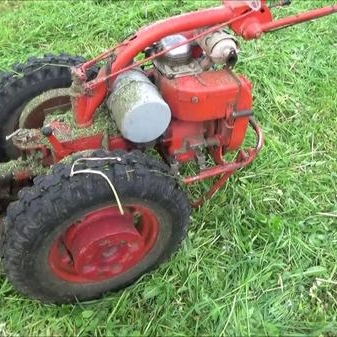

- When connecting the knots of the future lawn mower with the walk-behind tractor, the knives must be protected by a casing. Unfortunately, cases of unintentional start-up of equipment during installation are not so uncommon, and if an unlucky master, without heeding this advice, is too close to them at that very moment, it can end very sadly for him.
- Remember that mowing is usually done at low engine speeds, because otherwise the machine will turn the green matter into dust and become much more difficult to collect. The clutch must be engaged before starting the process



- As reliable as the connection between a trailed lawn mower and a walk-behind tractor may seem, it is usually not so strong, and this is most clearly observed at the moment of a sharp turn. For this reason, people with extensive experience with walk-behind tractors and home-made mowers advise avoiding not only too sharp corners, but also high speed when turning and even just sudden movements at the time of making a turn. The detached structure, even in the best case, will delay the mowing for some time until the malfunction is eliminated; in some situations, the trailer, having detached, may continue to move along an unpredictable trajectory.The latter option is especially dangerous for anyone in the vicinity due to the potential for serious injury from contact with the still rotating knives.

See the next video for more details.



































































The comment was sent successfully.